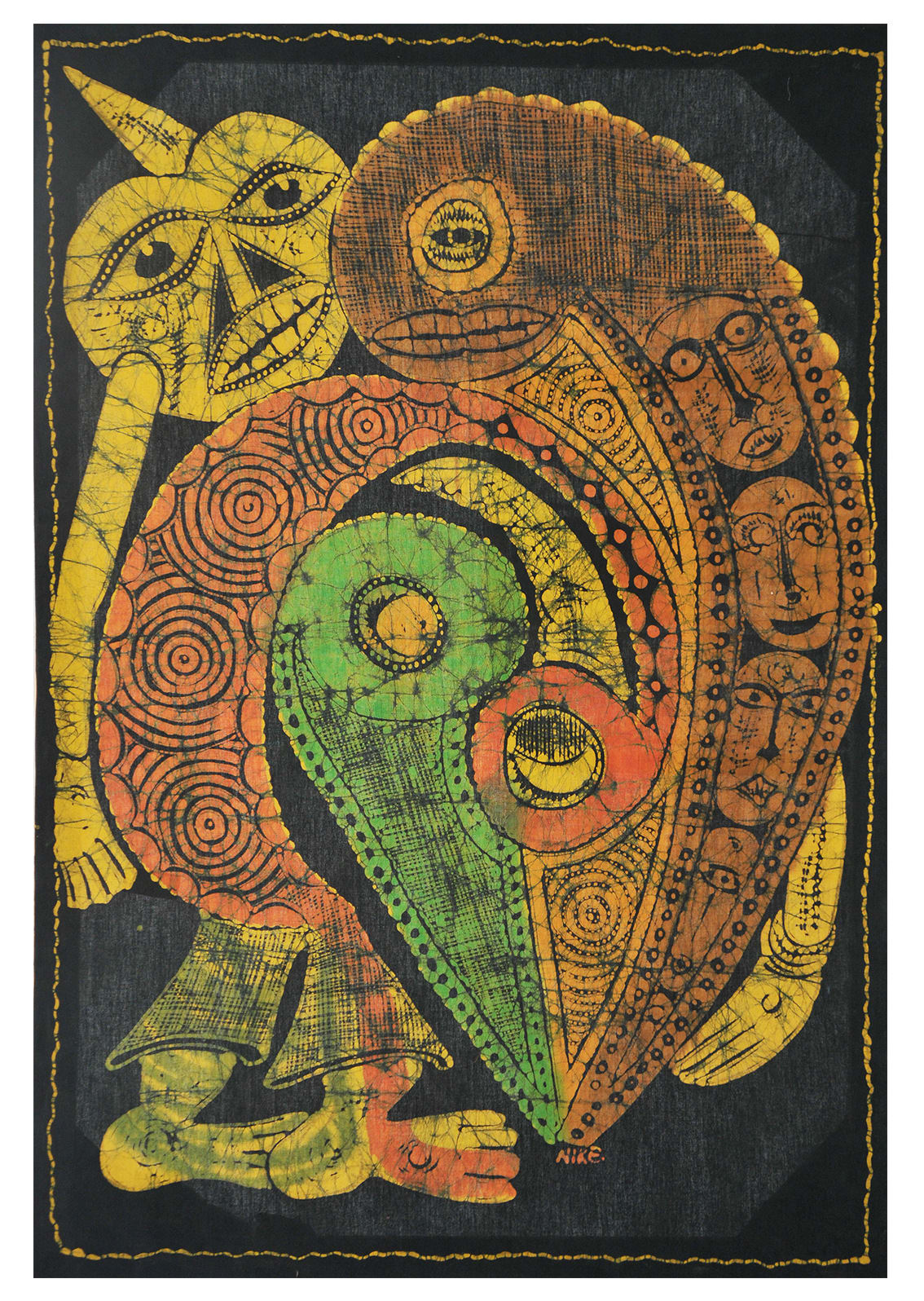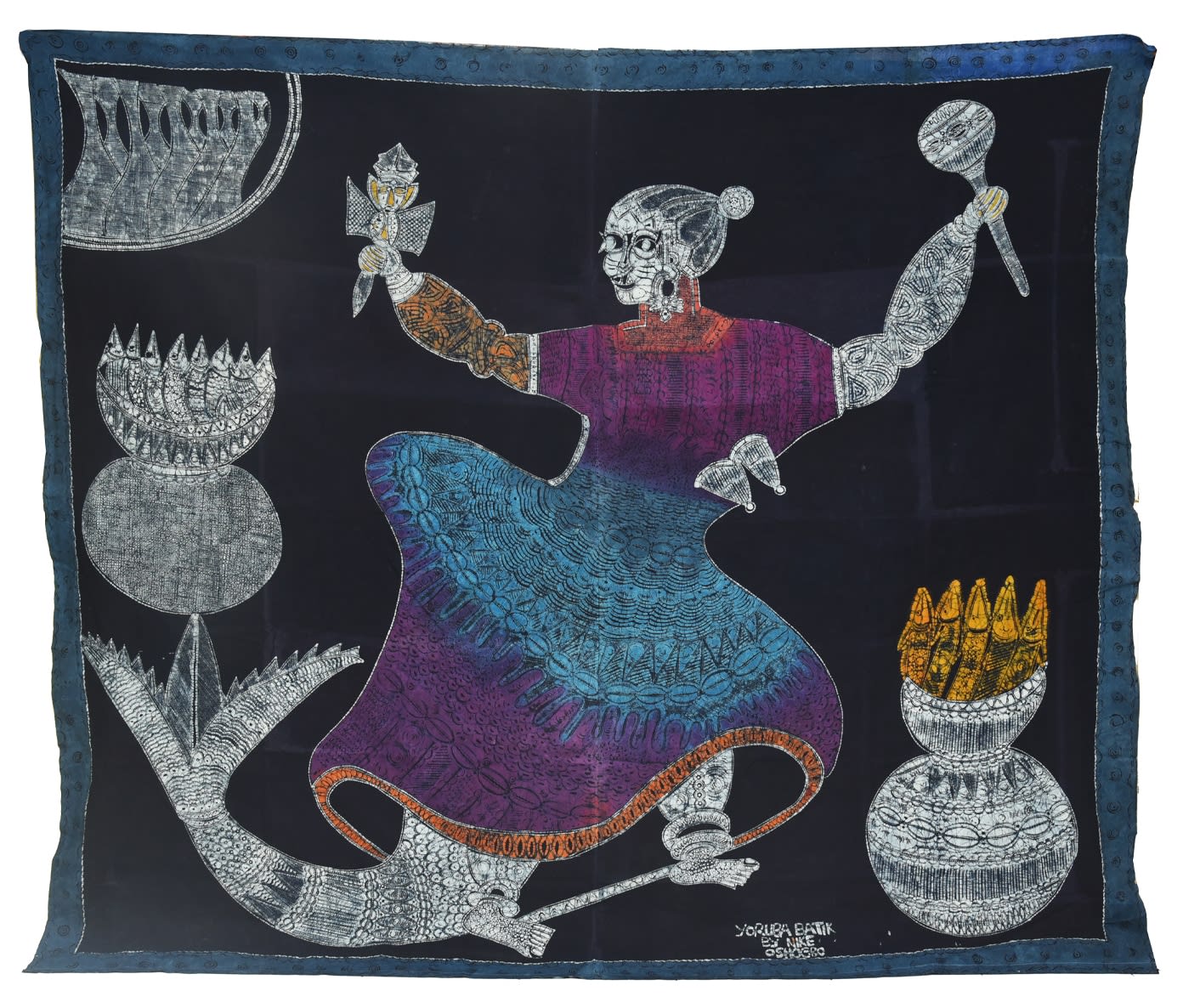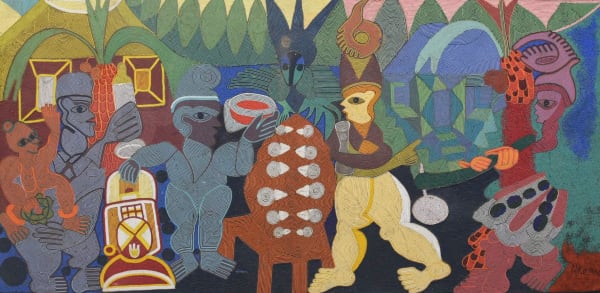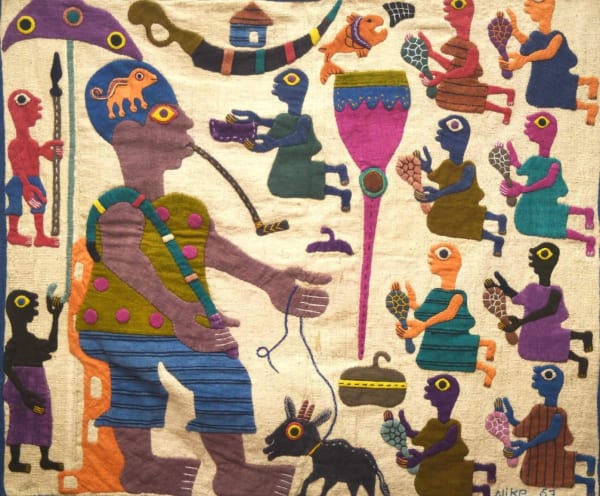Frieze Masters: Nike Davies-Okundaye
kó presents Nike Davies-Okundaye at Frieze Masters London in the Spotlight section, dedicated to pioneering women artists of the twentieth century.
This presentation highlights the artist’s groundbreaking work in textiles, dyeing, weaving, beadwork, painting and embroidery, from the 1960s-1980s.
Chief Nike Davies-Okundaye is an internationally renowned batik and Adire textile artist. Born in 1951 in Ogidi, Nigeria, she is a central figure in the revival of traditional Nigerian arts with a career that has spanned more than five decades. She is best known for her exploration of Adire designs, a traditional Yoruba technique using indigo dyes on hand painted cloth. Traditional Adire designs embody cultural and historical meanings, combined into larger overall patterns that are recognized in Yoruba culture. She was particular drawn to its cultural significance as a “woman’s art,” passed down by successive generations of women. Nike was inspired by old methods of weaving and dying that were fading away.

With no formal art education, Nike is a fifth-generation artist from a family of craftsmen. She became an apprentice to Susanne Wenger, an Austrian artist living in Osogbo, a major center for art and culture in Nigeria. She became known as part of the Osogbo Art Movement of the 1960s, which arose in the newly independent Nigeria. With an interest in Yoruba spirituality, the Osogbo School focused on re-engaging traditional artistic practices alongside elements of modernism. Affectionally known as “Mama Nike”, she is a seminal figure of the Nigerian art community, with four art centres throughout the country.
Nike began weaving at the age of six, learning from her great-grandmother who was a weaver and Adire textile maker. Her first solo exhibition was held in 1968 at the Goethe Institute, Lagos. Since then, she has held over 102 solo art exhibitions and participated in 36 group art exhibitions. In 1974, Nike was one of ten African artists who toured and taught arts in various crafts institutions in the United States, taking her to all fifty states to conduct workshops and deliver lectures in schools and community centers. She has continued to serve as a guest lecturer in traditional textile techniques at universities worldwide, including Harvard University. Her work is in the permanent collections of the Smithsonian Museum, National Museum of African Art, in Washington DC; the Gallery of African Art, London; The British Library; the Victoria and Albert Museum; the Museum of Natural History, New York; Iwalewa-Haus, University of Bayreuth, Germany; and Hood Museum of Art, Dartmouth, among others.

Alongside her artistic practice, Nike is known for her support of women in the craft industry. She is the founder and director of four art centers in Nigeria that offer free training in visual, musical and performing arts. In Osogbo, she teaches indigo cloth-dyeing techniques to rural women. She is the owner of Nike Art Gallery, the largest private art gallery in Africa with over 8,000 artworks spanning five floors.
In 2000, she was invited by the Italian government to train young Nigerian sex workers in Italy crafts, which led to aiding over 5,000 women by teaching them Adire production, weaving and other arts. She received recognition for her work by the United Nations and was awarded one of the highest Italian national awards of merit by the government of the Republic of Italy in appreciation of her efforts in using art to address and solve the problems of sex workers. She has received numerous awards for her contributions to Nigerian arts and culture. In 2004, she was appointed a member of the UNESCO Committee of the Nigerian Intangible Cultural Heritage Project. In 2005, the National Commission for Museum and Monument of Nigeria awarded Nike a certificate of excellence in recognition of her efforts in the development of Nigerian cultural heritage.In 2006, Nike was appointed a board member of the Federal Capital Territory of Nigeria Tourism Board in Abuja, Nigeria. Nike holds the chieftaincy titles of the Yeye Oba of Ogidi-Ijumu and the Yeye Tasase of Oshogbo.
This presentation is organized by Kavita Chellaram and Joseph Gergel of kó, with curatorial support from Jareh Das.
About Jareh Das
Based between West Africa and the UK, Dr. Jareh Das is a researcher, writer and curator, whose focus of study has included the politics of clay, contemporary performance art with a focus on site-responsive performance in West Africa, and the work of Donald Rodney. Her interests in (global) modern and contemporary art are cross-disciplinary, although her understanding is filtered through the lens of performance art which informs both her academic and curatorial work. In 2022, Das was awarded a two-year early career fellowship from Paul Mellon Centre for Studies in British Art as part of their New Narratives Awards. She holds a doctorate in Curating Art and Science: New Methods and Sites of Production and Display in partnership with Arts Catalyst and Royal Holloway, the University of London funded by Arts Humanities Research Council (AHRC); an MA in Curating Contemporary Art (Inspire), the Royal College of Art, London funded by Arts Council England (ACE); and a BA (Hons) in Material Culture, Architecture and Museum Studies from the University of Leeds.
-
 Nike Davies-Okundaye, Animal World, 1968
Nike Davies-Okundaye, Animal World, 1968 -
 Nike Davies-Okundaye, Osun, 1972
Nike Davies-Okundaye, Osun, 1972 -
 Nike Davies-Okundaye, The finger that feeds never lacks, 1979
Nike Davies-Okundaye, The finger that feeds never lacks, 1979 -
 Nike Davies-Okundaye, Woven in Love, 1977
Nike Davies-Okundaye, Woven in Love, 1977
-
 Nike Davies-Okundaye, The palmwine tapper and ayo game, 1969-1970
Nike Davies-Okundaye, The palmwine tapper and ayo game, 1969-1970 -
 Nike Davies-Okundaye, Marriage of the Gods, 1982
Nike Davies-Okundaye, Marriage of the Gods, 1982 -
 Nike Davies-Okundaye, Iya Ibeji (Mother of twins), 1982
Nike Davies-Okundaye, Iya Ibeji (Mother of twins), 1982 -
 Nike Davies-Okundaye, Osun, The Goddess of the River, 1987
Nike Davies-Okundaye, Osun, The Goddess of the River, 1987
-
 Nike Davies-Okundaye, Untitled, 1982
Nike Davies-Okundaye, Untitled, 1982 -
 Nike Davies-Okundaye, Untitled, 1979
Nike Davies-Okundaye, Untitled, 1979 -
 Nike Davies-Okundaye, African ceremony, 1967
Nike Davies-Okundaye, African ceremony, 1967 -
 Nike Davies-Okundaye, The Mushroom of Life, 1977
Nike Davies-Okundaye, The Mushroom of Life, 1977
Textiles from a personal and social perspective in the work of Nike Davies-Okundaye
Chief Mrs. Nike Davies-Okundaye (or Mama Nike as she is widely and affectionately known) has had an extraordinary life rising above personal circumstances to becoming globally recognised as a multifaceted textile artist, social activist, educator, and feminist. With a career spanning over fifty years, Davies-Okundaye is renowned for reviving and preserving adire traditions in Nigeria with her established Nike Art centres, notably the centre in Osogbo dedicated to promoting and sustaining local female Adire makers.
Adire textile is created through a process of indigo resist-dyeing cotton that involves creating a pattern on the fabric and preventing it from absorbing the indigo dye. Three types of techniques are commonly used to achieve this effect: Onikan, Alabere and Eleko, the latter a more widespread method that involves creating designs by drawing with cassava paste onto the cloth’s surface. The production of this cloth involves dyeing cotton in large clay pots sunken in the ground, followed by a procedure of dipping and airing to create the bright blue colours of the resulting fabric. Indigo dye is produced from leaves grown locally that have undergone a fermentation process to create different indigo hues. From the mid-1920s onward, adire and other textile industries across Nigeria and other parts of the African continent have seen a devastating decline in production and distribution due to a range of factors including limited governmental investment in infrastructure, political instability, and the importation of second-hand clothes from the West.
In her hometown of Ogidi Ijumu, Kogi State, during her childhood, Davies-Okundaye’s late father embroidered ceremonial agbadas, the four-piece male attire mostly found among the Yoruba of southwestern Nigeria and other parts of the country. Important rulers and leaders commissioned her father due to his talent and skill, and with her late mother, both would join in embroidering and beadwork to counter the arduous and painstaking task of creating this artform. Conversely, alongside embroidery, the artist was also taught to weave on the loom and work with adireby her grandmother, using the resist dye technique batik to produce intricate patterns on predominately indigo-coloured fabrics. Agbadas consist of a loose and free-flowing outer robe (awosoke), an undervest (awotele), a pair of long trousers (sokoto), and a hat (fìla). It is from this outer robe that the entire outfit derives the name agbada, a big, loose-fitting, ankle-length garment with a distinct and embroidered rectangular centrepiece, flanked by wide sleeves rolled over or thrown across arms as wearers go about their activities. The intricacy and complexity of the agbada’s centrepiece embroidery vary depending on how much the wearer is willing to pay.
This display of early works by Davies-Okundaye in the Frieze Masters Spotlight section spans twenty years, beginning in the 1960s through the 1980s. This selection highlights the importance of familial craft traditions of beadwork, embroidery, and batik passed down from one generation to the next. Additionally, Davies-Okundaye has been greatly influenced by the formative and lifechanging years she spent in Osogbo, engaging with the town and its artists at the height of its creativity between the 1950s and 1960s, including Twins Seven Seven, Susan Wenger, and Ulli and Georgina Beier. Her Osogbo years contributed to giving visibility to the young artist, and a first United States trip in 1974 to teach weaving at the Haystack Mountain School of Crafts led to an engagement with American quilt making traditions. These resulting hybrid adire quilts are shown here publicly in the UK for the first time.
A pair of embroidered artworks Animal World (1968) and Osun (1972) are indicative of Davies-Okundaye’s deft understanding of stitchwork, a skill she learned as a child in these renderings of everyday life and the animals she would have encountered growing up, alongside her deep engagement with Yoruba culture celebrating the god of Osun. The large-scale beadwork, The palm wine tapper and Ayo game (1969-1970) is a significant work rendered painstakingly in an expansive surface over 2.5 meters wide, meticulously adorned with multicoloured beading. The central figure, the palm wine tapper, is flanked by both mythical human and perhaps animal figures in a communal scene depicting the popular Yoruba game ayo, a game no doubt familiar to the artist and others across Nigeria as a popular leisurely pastime. Early batiks including Woven in Love (1977) and The finger that feeds never lacks (1979) demonstrate the artist’s mastery of free-hand figurative drawing in the textile medium, one that she has mastered over time and continues to explore, expand, and evolve.
In her recent autobiography, titled A Biography of Níke: Bàtà Mi A Dùn KòKò Ká by writer and historian Kofo Adeleke, the artist describes the soil as her slate and broomstick her pencil of her early creative engagements. Celebrating the brilliance and determination of Davies-Okundaye, whose life as a theatrical lens has deeply informed her work to date, this narrative display begins with Nigerian familial craft traditions, but through this, the formidable artist Mama Nike continues to expand both the meaning and scope of textile as a contemporary artform. Her beginnings as an artist also reveal a life dedicated to individual artistic expression, curiosity, female empowerment, and transformation.
































